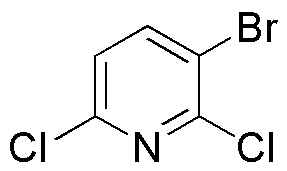3-Bromo-2,6-dichloropyridine is widely utilized in research focused on:
- Pesticide Development: This compound serves as an important intermediate in the synthesis of various agrochemicals, particularly herbicides and insecticides, enhancing crop protection and yield.
- Pharmaceuticals: It is used in the development of pharmaceutical agents, particularly those targeting bacterial infections and other diseases, offering potential therapeutic benefits.
- The compound is employed in the creation of advanced materials, including polymers and coatings, which provide improved durability and resistance to environmental factors.
- Research Applications: In academic and industrial laboratories, it is utilized as a reagent in organic synthesis, aiding researchers in the development of new compounds with desired properties.
- Environmental Studies: The chemical is important for studies related to environmental chemistry, particularly in assessing the behavior and degradation of chlorinated compounds in ecosystems.
General Information
Properties
Safety and Regulations
Applications
3-Bromo-2,6-dichloropyridine is widely utilized in research focused on:
- Pesticide Development: This compound serves as an important intermediate in the synthesis of various agrochemicals, particularly herbicides and insecticides, enhancing crop protection and yield.
- Pharmaceuticals: It is used in the development of pharmaceutical agents, particularly those targeting bacterial infections and other diseases, offering potential therapeutic benefits.
- The compound is employed in the creation of advanced materials, including polymers and coatings, which provide improved durability and resistance to environmental factors.
- Research Applications: In academic and industrial laboratories, it is utilized as a reagent in organic synthesis, aiding researchers in the development of new compounds with desired properties.
- Environmental Studies: The chemical is important for studies related to environmental chemistry, particularly in assessing the behavior and degradation of chlorinated compounds in ecosystems.
Documents
Safety Data Sheets (SDS)
The SDS provides comprehensive safety information on handling, storage, and disposal of the product.
Product Specification (PS)
The PS provides a comprehensive breakdown of the product’s properties, including chemical composition, physical state, purity, and storage requirements. It also details acceptable quality ranges and the product's intended applications.
Certificates of Analysis (COA)
Search for Certificates of Analysis (COA) by entering the products Lot Number. Lot and Batch Numbers can be found on a product’s label following the words ‘Lot’ or ‘Batch’.
*Catalog Number
*Lot Number
Certificates Of Origin (COO)
This COO confirms the country where the product was manufactured, and also details the materials and components used in it and whether it is derived from natural, synthetic, or other specific sources. This certificate may be required for customs, trade, and regulatory compliance.
*Catalog Number
*Lot Number
Safety Data Sheets (SDS)
The SDS provides comprehensive safety information on handling, storage, and disposal of the product.
DownloadProduct Specification (PS)
The PS provides a comprehensive breakdown of the product’s properties, including chemical composition, physical state, purity, and storage requirements. It also details acceptable quality ranges and the product's intended applications.
DownloadCertificates of Analysis (COA)
Search for Certificates of Analysis (COA) by entering the products Lot Number. Lot and Batch Numbers can be found on a product’s label following the words ‘Lot’ or ‘Batch’.
*Catalog Number
*Lot Number
Certificates Of Origin (COO)
This COO confirms the country where the product was manufactured, and also details the materials and components used in it and whether it is derived from natural, synthetic, or other specific sources. This certificate may be required for customs, trade, and regulatory compliance.


